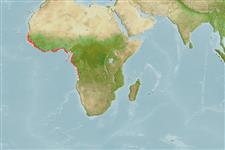Environment: milieu / climate zone / गहराई सीमा / distribution range
पारिस्थितिकी
समुद्री ड़िमरसल; गहराई सीमा 80 - 300 m (Ref. 3589). Tropical; 17°N - 13°S, 19°W - 15°E (Ref. 5222)
Eastern Atlantic: Mauritania (Ref. 5377) and Senegal to southern Angola.
आकार / वज़न / Age
परिपक्व अवधि: Lm ? range ? - ? cm
Max length : 140 cm TL पुल्लिंग / अलिंग; (Ref. 5377); common length : 50.0 cm TL पुल्लिंग / अलिंग; (Ref. 26999)
पृष्ठीय रीढ़ (सम्पूर्ण) : 11; पृष्ठीय सौफट रेज़ (सम्पूर्ण) : 16; गुदा कांटा: 3; ऐनल सौफट रेज़: 8. Distinguished by the following characteristics: brownish head and body; 3-4 broad oblique bars on the dorsal part of the body and another on the dorsal half of the peduncle; 2 narrow faint dark bands extending posteriorly from the lower half of the eye; presence of dark moustache streak, not extending past the rear end on maxilla; body depth less than head length, depth contained 2.9-3.2 times in SL; head length 2.5-2.7 times in standard length; flat or slightly convex interorbital area; angular preopercle, 3-4 enlarged serrae at the angle, lowermost directed ventrally; serrate interopercle and subopercle; well developed middle and lower opercular spines, upper spine not apparent; approximately straight upper edge of operculum; maxilla reaches vertical at rear edge of eye; maxilla naked or with few minute scales dorsally; 2 rows of teeth on midlateral part of lower jaw; posterior nostril about twice the size of anterior nostril (Ref. 89707).
Body shape (shape guide): fusiform / normal; Cross section: compressed.
Reported to occur from a variety of habitats (rock, mud and sand). The adults live in relatively deeper waters (Ref. 5377). Little is known about its biology.
Life cycle and mating behavior
परिपक्व अवधि | पुनरुत्पत्ति | मछलीऔ का अंडे देना | अंडे | Fecundity | लार्वा
Heemstra, P.C. and J.E. Randall, 1993. FAO Species Catalogue. Vol. 16. Groupers of the world (family Serranidae, subfamily Epinephelinae). An annotated and illustrated catalogue of the grouper, rockcod, hind, coral grouper and lyretail species known to date. Rome: FAO. FAO Fish. Synop. 125(16):382 p. (Ref. 5222)
IUCN Red List Status (Ref. 130435: Version 2025-1)
Threat to humans
Harmless
Human uses
मात्स्यिकी: निर्वाह मात्स्यिकी
साधन
Special reports
Download XML
इंटरनेट स्रोत
Estimates based on models
Preferred temperature (संदर्भ
123201): 14.2 - 16.4, mean 15.3 °C (based on 16 cells).
Phylogenetic diversity index (संदर्भ
82804): PD
50 = 0.5000 [Uniqueness, from 0.5 = low to 2.0 = high].
Bayesian length-weight: a=0.01072 (0.00588 - 0.01953), b=3.03 (2.88 - 3.18), in cm total length, based on LWR estimates for this species & Genus-body shape (Ref.
93245).
Trophic level (संदर्भ
69278): 3.9 ±0.64 se; based on food items.
लौटाव (संदर्भ
120179): माध्यम, न्यूनतम जनसंख्या दुगनी होने का समय 1.4 - 4.4 वर्ष। (Assuming tm=3-4).
Fishing Vulnerability (Ref.
59153): Very high vulnerability (84 of 100).
🛈
Climate Vulnerability (Ref.
125649): Very high vulnerability (83 of 100).
🛈
Nutrients (Ref.
124155): Calcium = 42.3 [16.9, 97.0] mg/100g; Iron = 0.731 [0.329, 1.668] mg/100g; Protein = 17.7 [16.0, 19.2] %; Omega3 = 0.187 [0.095, 0.360] g/100g; Selenium = 97.9 [44.0, 230.9] μg/100g; VitaminA = 30.3 [7.3, 126.4] μg/100g; Zinc = 1.03 [0.64, 1.70] mg/100g (wet weight);
